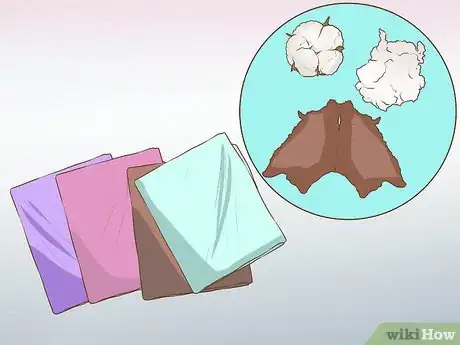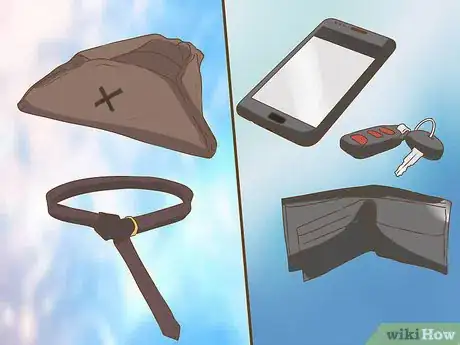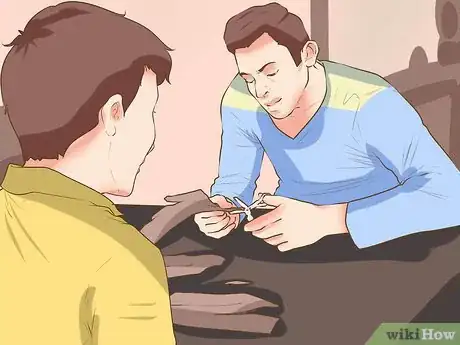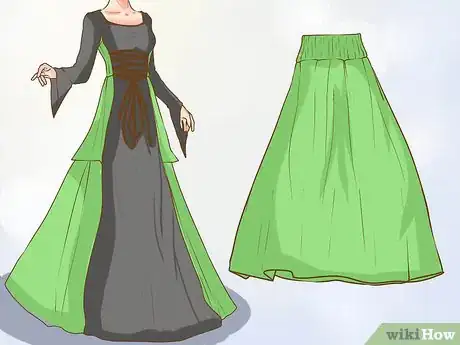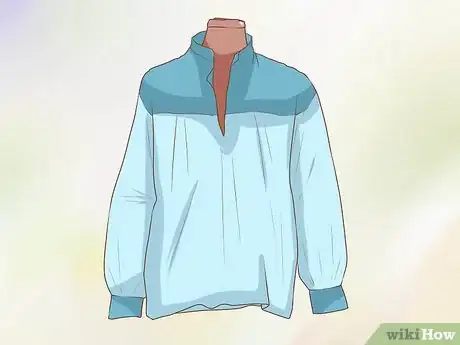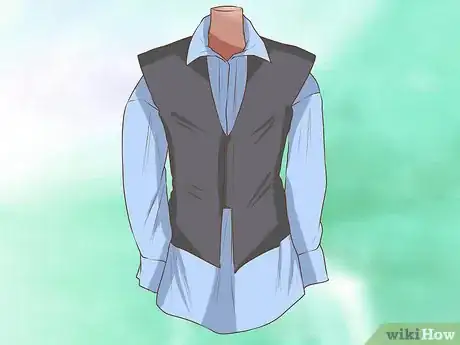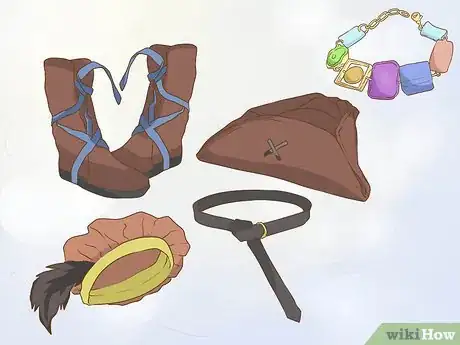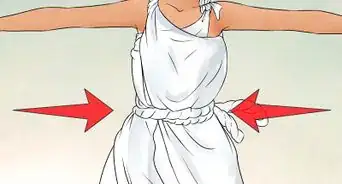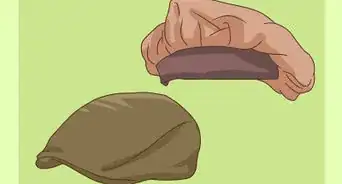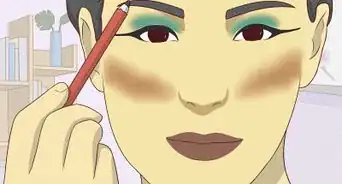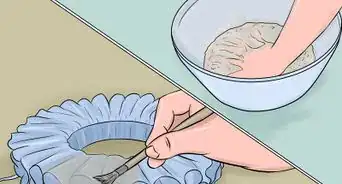This article was co-authored by Alina Bokovikova. Alina Bokovikova is a Costume Designer from California. With over 15 years of experience, she specializes in designing costumes for stage productions. Alina earned an MFA in Costume Design from the University of California, San Diego and her Master of Education from the Novosibirsk Pedagogical University. She’s won two Outstanding Costume Design awards and her costumes have been displayed in Moscow, Prague, and San Jose, California.
wikiHow marks an article as reader-approved once it receives enough positive feedback. In this case, 100% of readers who voted found the article helpful, earning it our reader-approved status.
This article has been viewed 162,062 times.
Renaissance faires are a fun way to transport yourself back in time to the Renaissance, a period in European history famous for a “rebirth” of art, science, and entertainment. Many Renaissance faire attendees enjoy immersing themselves fully in this past time period by dressing, acting, and speaking in a manner authentic to the people of that time. Learn how to make or find your own authentic outfit to wear to a Renaissance faire.
Steps
Choosing a Renaissance Costume
-
1Decide who you want to portray. Choose a character or a type of person to dress as at a Renaissance faire, or just what type of look you’d like to borrow ideas from. Use this as your foundation for putting together an outfit.
- Some common “characters” to dress as are peasants, pirates, wenches, and royal nobility.
- It may help to sketch out a design on paper, or save images of pieces that you like and want to find, make, or otherwise emulate.
- Note that while many people choose to dress according to the era, which is typically set in Elizabethan England at most faires, Renaissance faires have also become a gathering place for a wide variety of subcultures and cosplay (costume play) of all kinds, whether or not it relates to the time period.
-
2Consider class and profession. Decide whether you’d like to dress as someone of lower or higher class, typically either a peasant or noble. Also consider if the type of person you portray has a specific job or trade.
- For example, you might wear a dirty leather apron as a blacksmith, a flour-dusted apron and hat as a baker, and a typical “wench” outfit as the owner of a tavern or inn.[1]
- You may also dress as a higher class person, or even royalty, who would not have worked in difficult trade or labor and would thus wear more high quality and expensive fabrics and outfits.
Advertisement -
3Dress for an activity. Consider what you might be doing at the Renaissance faire, or what the character you portray might do as a leisure activity, sport, or performance. Take practicality in consideration with authenticity.
- For example, you might be riding a horse, dancing, or working at a trade, all of which might warrant slightly different attire.
- Keep in mind the weather on the day of the Renaissance faire as well. They are often held in summer, so you may not want to wear quite as many layers as might have been typical for some period outfits.
-
4Favor simple fabrics. Remember that if you are going for authenticity, you should look for fabrics that would have been available in the 14th-17th century, or at least closely resemble such. Consider both color and fabric type when purchasing your garments.
- Look for earth tones like green, brown, beige, and rust. Choose pure white only when dressing as an upper class person, and purple only for the highest royalty. Avoid neon colors, patterns, and other bright modern shades.
- Choose fabrics made with natural fibers or materials, as synthetic fabrics were not yet invented in this time period. Go for cotton, raw silk, linen, woven cotton, wool, and leather. Use velvets, satins, and brocades only for high class and royalty costumes.[2]
-
5Accessorize appropriately. Add to your clothing with accessories made from leather or other natural materials that might have been seen during the Renaissance. Remember to keep it simple and period-specific if you can.
- Try a simple leather belt and attach one or more pouches, also made of leather or a natural fiber, as a nice accessory as well as a way to hide away 21st century things like cell phones, wallets, and car keys![3]
- Don a tricorn hat for a classic pirate-type look, or a bonnet-like “muffin” hat for a female peasant costume.
- Choose sturdy leather boots, if possible, or other practical footwear made of natural material.
- Note that many Renaissance faire venues won’t allow real weapons inside unless you’re a performer, so opt for a costume sword or another decorative-only weapon for your accessories.[4]
-
6Try making your costume. Make your Renaissance faire costume yourself if you have the skill and the right tools and materials available. Seek assistance from another tailor or costume designer if you need assistance on unusual garments.
- Check fabric and craft stores near you for sewing patterns for garments of the time period, like bodices, skirts, breeches, and doublets.
- Look online for more sewing patterns, inspiration on the type of pieces you’d like to make yourself, or even suggestions on how to alter existing clothing to make it more period-accurate.
-
7Buy your costume pre-made. Check out costume retailers or specialty stores for items meant to portray the Renaissance time period. You may only need to buy a few pieces to form a simple but authentic outfit.
- Try thrift or secondhand stores, garage sales, or vintage shops for used costume or specialty items.
- Check websites like Ebay and other locations that may be easier to search for specific items.
- You can also buy clothing directly from sellers at a Renaissance faire, and either change your clothes there or save it for the next faire you attend.
Dressing as a Renaissance Woman
-
1Consider undergarments. Look for a chemise, the long shift worn as the base layer for female Renaissance clothing. You can forgo or supplement modern underwear with this garment.
- A half size chemise is like a loose blouse, while a full size is like a long, loose nightgown. Substitute a long shirt or nightgown in a light, neutral color if you can’t acquire an authentic chemise.[5]
- Forgo a modern bra if you plan to wear a traditional corset or structured bodice, as these will provide support for your chest and be more accurate to the time period if you’re going for full authenticity.
-
2Choose a corset or bodice. Cinch a corset or a pull on a structured bodice over your chemise to achieve the narrow hourglass shape that was popular in all classes for women of the Renaissance period. Find modern and more vintage styles available widely in stores.
- You can wear a corset or bodice as the main outer garment for your upper body, or you can use one as support and structure for a top and skirt or dress that you pull over it.
- Make sure any very fitted garment like a corset is not worn to the level of discomfort or for a very long period of time.
-
3Don a skirt or dress. Wear a skirt or dress that reaches the floor or your ankles for a typical Renaissance look. Wear a gown or dress over your chemise and corset, or a separate skirt to complement your corset or bodice.
- Avoid any ruffles, adornments, or patterns on skirts. For more volume, add crinoline or other layers underneath your main skirt.
- Wear two or more skirts layered over one another and tuck the the top layer up into the waistband at the sides for a typical peasant look and shape.[6]
- The costume for a woman of nobility would include a more formal and elaborate gown, made of velvet or silk and including a very full hoop skirt or “farthingale” underneath.[7]
-
4Keep jewelry and accessories simple. Don a hat and belt and opt for jewelry with natural metal or stones. Remember that you want to keep the jewelry authentic if you aim for a period costume.
- Go for light or no makeup, unless you are achieving a nobility look, in which case pale powder and dramatic rouge are acceptable.
- Nobility can wear a girdle adorned with chains, jewels, and a purse that matches the gown. A fold-out fan is also a high class accessory.
- Pull your hair up into a snood (a traditional hair net to hold back the hair), a simple clip, or a bonnet or other hat to keep you cool for a summer Renaissance faire.[8]
-
5Wear sensible flat shoes. Keep footwear plain and simple, in a material like leather if possible. Try flats or boots worn under your dress or skirt.
- Note that flat, practical shoes have the added real-world benefit of being more comfortable when walking around Renaissance faire grounds.
- Don’t worry too much about the authenticity or quality of shoes compared with the rest of the outfit, as they will mostly be hidden under long skirts anyway.
Dressing as a Renaissance Man
-
1Don simple breeches. Wear pants in earth tone shades that have a lot of volume and fall at the knee, or just above or below. These are often referred to as breeches or knickers.
- Avoid pants with pockets, zippers, or other closures or embellishments. Stick to only drawstrings at the waist and hem for closure.
- Cover the rest of the leg that is showing below your breeches with hose or wool socks, unless you are portraying an Irish or Scottish Renaissance man, for which bare legs were acceptable.[9]
-
2Wear a loose-fitting shirt. Choose a loose, simple shirt for your upper body, sometimes called a poet shirt, with long sleeves and a low or drawstring neckline. Find this type of shirt in most vintage or costume stores.
- Remember to favor simple colors and fabrics. Renaissance men’s shirts were typically cotton and off-white or beige in color.
- Opt for a shirt with no collar, a drawstring collar, a drop collar, or a high collar for an authentic look.[10]
- For a noble gentleman, the shirt may have lace details, or be made of silk.
-
3Top with a jerkin or doublet. Put on a loose fitting sleeveless vest (jerkin) or a form-fitting vest with detachable sleeves (doublet). Consider this as a nice practical addition when weather is cooler.
- A simple jerkin can look more simple and suitable for peasantry, or more formal and suited to nobility, depending on the style and quality of fabric.
- For an outfit for nobility, find a doublet in velvet or corduroy, and match the color of it to your breeches.[11]
-
4Use accessories wisely. Don a hat, belt, and boots, and use other accessorizing minimally and according to trade. When in doubt, keep accessories minimal.
- Stick to sensible, durable shoes, preferably in leather. A peasant or tradesman might wear leather boots, while nobility might have short laced and polished shoes.
- Find sheaths or other holders for weapons to attach to your belt. Get costume weapons to comply with any safety standards the faire might have in place.
- No hat or a leather cap is acceptable for a peasant male. A floppy hat made of velvet or a hunter’s cap is appropriate for nobility.[12]
Community Q&A
-
QuestionCan an upper class male wear a bit of eyeliner?
 Community AnswerIt would probably be fine for an aristocrat to wear some eyeliner. A good option for application is to rim your eyes to make them pop and look sensual.
Community AnswerIt would probably be fine for an aristocrat to wear some eyeliner. A good option for application is to rim your eyes to make them pop and look sensual. -
QuestionIf I'm going to a renaissance festival and I am a woman. I am riding horses and shooting archery. Is it acceptable to wear pants?
 Community AnswerFor your line of work, such items of clothing are probably necessary and would not cause a problem. If you wanted to stay more true to the era, you could choose to wear leggings with boots and a skirt with slits in the sides, to allow both movement and coverage.
Community AnswerFor your line of work, such items of clothing are probably necessary and would not cause a problem. If you wanted to stay more true to the era, you could choose to wear leggings with boots and a skirt with slits in the sides, to allow both movement and coverage. -
QuestionWould a light shawl or thin cape for women would be okay? I burn easily so I'm trying to minimize sun exposure.
 Community AnswerYes. In the renaissance period, many working class women wore shawls over their loops to protect their skin and to lessen exposure.
Community AnswerYes. In the renaissance period, many working class women wore shawls over their loops to protect their skin and to lessen exposure.
Expert Interview

Thanks for reading our article! If you'd like to learn more about Renaissance costumes, check out our in-depth interview with Alina Bokovikova.
References
- ↑ http://www.renfaire.com/Acting/professions.html
- ↑ http://www.renfaire.com/Costume/costume-guide.html
- ↑ http://www.fairsandfestivals.net/articles/view/what-to-wear-to-a-renaissance-faire/509
- ↑ http://www.buycostumes.com/ideas/trends/renaissance-faires/
- ↑ http://www.fairsandfestivals.net/articles/view/what-to-wear-to-a-renaissance-faire/509
- ↑ http://www.renfaire.com/Costume/costume-guide.html
- ↑ http://www.fairsandfestivals.net/articles/view/what-to-wear-to-a-renaissance-faire/509
- ↑ http://www.fairsandfestivals.net/articles/view/what-to-wear-to-a-renaissance-faire/509
- ↑ http://www.renfaire.com/Costume/costume-guide.html
About This Article
To dress for a renaissance fair, you’ll want to find a loose-fitting outfit made of natural fabrics, like a medieval dress or tunic and pants. Decide what kind of character you want to dress as, like a peasant, pirate, wench, or nobleman. You can find a costume online or in a costume store. Alternatively, mix and match your own clothes. Look for clothes made from cotton, raw silk, linen, wool, and leather. Traditional renaissance clothes are in earth tones like green, brown, beige, and white. You can wear a corset, bodice or long dress. Or, wear breeches with a loose fitting shirt and jerkin. Keep your footwear simple, like unbranded boots or flat shoes. For more tips, including how to accessorize your renaissance outfit, read on!



